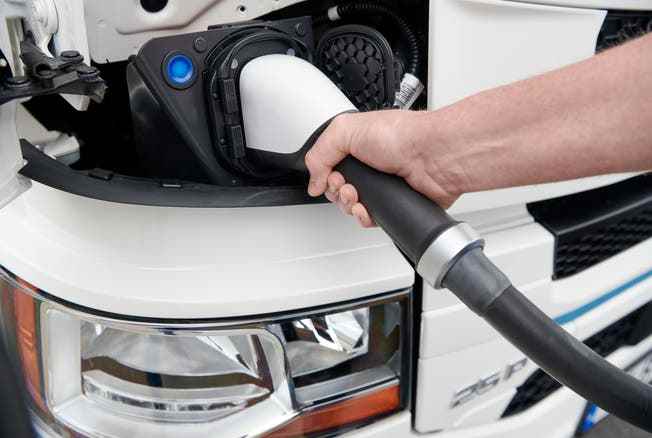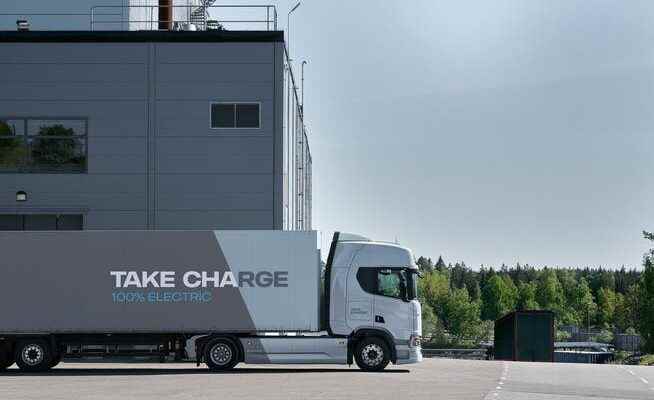Emission-free heavy traffic on the road is increasingly relying on battery drives, the hydrogen truck is becoming a marginal phenomenon. An amazing change, for which there are good reasons.
For emission-free long-distance transport, Scania is currently using tractors with battery-electric drives.
That’s how you can fool yourself. Up until around seven years ago, it was considered almost impossible to make long-distance transport emission-free. Long-distance trucks were already so heavy that it seemed almost impossible to equip them with heavy batteries for electric propulsion. The fifth wheel load of the trucks would have been practically used up by the drive batteries.
The rescue, however, was an electrical system with an electric motor and fuel cell. Fueled with light hydrogen (H2) the truck became a zero-emission vehicle for long-distance journeys, and that with plenty of payload. Hyundai was one of the pioneers. The Korean company chose Switzerland in 2019 to launch a pilot project with up to 1,500 Xcient Fuel Cell trucks. The first vehicles were delivered from 2020.
Hydrogen propulsion causes problems in practice
But even with this smart solution, people were wrong. In Switzerland, the network of hydrogen filling stations is growing, but very slowly, because investing in an H2gas station goes into the seven-figure range despite state subsidies. To date, there are only eight filling stations for the still rare fuel in this country. The hydrogen network is not growing as fast as originally hoped.
A second problem arises from the production of the hydrogen. An H drives emission-free2-Trucks only if the hydrogen in the tank is produced with clean energy and stored in a cool place. The required amounts of “green” H2 were not ready for a widespread introduction of hydrogen trucks for heavy traffic on the road.
The established truck manufacturers such as Renault Trucks, Daimler Trucks, Volvo, MAN and Scania also developed trucks with fuel cell drives, but they lacked the know-how for this exotic technology. They considered other solutions, such as trucks with pantographs. This gets the energy to charge the drive battery from an overhead line. Trials by Scania and Daimler Trucks show that this works. For a comprehensive network of overhead lines, however, the effort seems too great.
Siemens and ABB adapted the pantograph system for short-distance journeys, such as those made by a bus in local public transport. Equipped with a relatively small drive battery, the e-bus can be recharged briefly at bus stops when it extends the pantograph. The required charging infrastructure appears to be significantly more cost-effective than for long-distance traffic with overhead lines. Such a system for shuttle buses between the ETH locations in Zurich has been in operation since 2020.
The Federal Council creates a solution
The solution for emission-free heavy truck traffic over long distances was still missing. Then something decisive happened: In order to promote decarbonization in the commercial vehicle sector as well, the Federal Council adjusted the regulations for trucks with alternative drive systems. From April 1, 2022, the maximum permissible weights of zero-emission heavy-duty vehicles and vehicle combinations will be increased by the additional weight of the zero-emission technology (but by a maximum of two tons). For alternative drives such as natural or liquid gas, the additional weight compensation is up to one ton.

More and more trucks can be refueled at charging stations.
“For us, since April this means that we can finally increase the total weight of electric trucks,” says Tobias Schönenberger, Head of Communications at Scania Switzerland. “So the weight is no longer a problem. However, it must be distributed in a balanced way across all axle loads.”
Scania is also developing its trucks with various alternative drive types such as hydrogen, biogas, biodiesel and hybrid variants. However, the poor overall efficiency of fuel cell vehicles, around 26 percent according to Schönenberger, makes the battery truck appear to be the currently most economical variant. Added to this are the currently sharply rising fuel costs for hydrogen, but also diesel.
Another problem becomes apparent when the hydrogen trucks sold by Hyundai in Switzerland are first used. The manufacturer reported a range of 400 kilometers for the Xcient Fuel Cell. That would be just enough to take a legally required break when the maximum permitted driving time is reached. In practice, however, according to information from the truck industry, it should only be 300 kilometers. With the truck drivers’ tight schedules, the refueling break comes too early and costs additional time. The refueling process can be done at H2 This can take up to 20 minutes, for example if the pump has just been used and the pressure has to be built up again for the next fill-up.
It is therefore clear: the calculation for the hydrogen truck in long-distance transport does not add up. As confirmed by Beat Hirschi, CEO of Hyundai Hydrogen Mobility AG, the sale of the Hyundai-H2-Trucks temporarily stopped in Switzerland. The planned 1,500 vehicles turned into just over 50. “Due to the unforeseeable and unplanned increase in electricity costs, the use of trucks in Switzerland is currently becoming enormously expensive, which puts a financial burden on individual companies,” explains Hirschi. “Until the situation clarifies and relaxes, the next series of Xcient Fuel Cell trucks will be placed in the European markets, depending on the development 200 to 500 trucks in the next two years.” Hirschi emphasizes that the company is sticking to the hydrogen-powered truck business.
Electricity is the most economical
So everything currently speaks in favor of the battery-electric truck. Accordingly, there are already a whole range of vehicles with battery drives and electric motors. In this year’s readers’ choice of the online portal Eurotransport.de, more than 20 different battery-powered models were selected for the German market. The market for battery-electric long-distance trucks in Europe is currently shared primarily by the major manufacturers such as Mercedes, Volvo, Scania, MAN, DAF, Iveco and Renault.
In the USA, something has also been happening in the field of long-distance truck transport with battery drives for several years. Although the manufacturers Tesla and Nikola already presented their vehicle concepts with full-bodied promises in 2016, by March 2022 none of the American electric trucks had rolled off the assembly line. Tesla heard in October that they wanted to deliver the first vehicles of the large electric tractor by the end of 2022. You have to rely on the verbal promise of Tesla boss Elon Musk here.
Things are looking better for Nikola. Production has been running since April. The partnership with the automotive group General Motors announced at the end of 2020 should have helped, but the deal fell through just a year later. Nikola founder Trevor Milton apparently made false promises about the capabilities of the truck models. The manufacturer is now fully committed to hybrid drives and fuel cells. In the long run, however, Tesla should be ahead with its battery tractors in America if the range of the batteries reaches the 800 kilometers promised by Musk. But one thing seems to be clear: Brummis become Surris.
